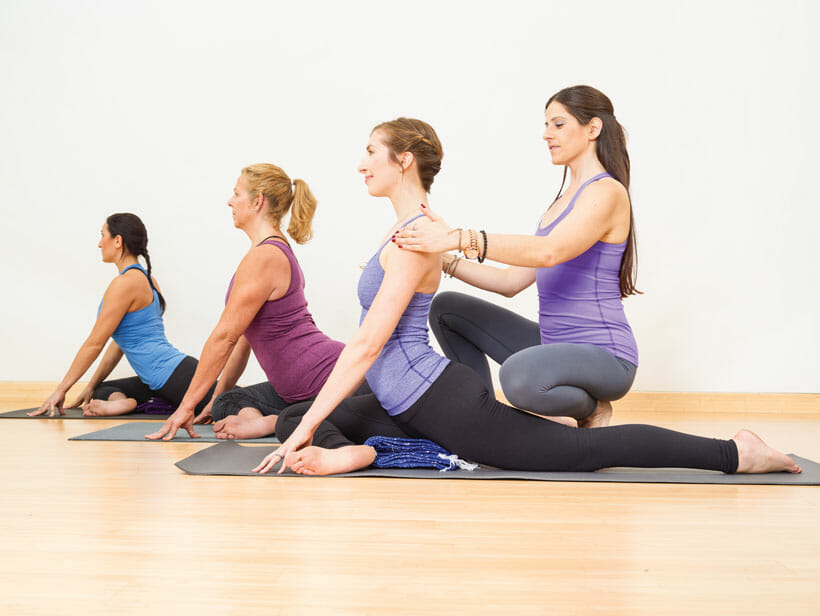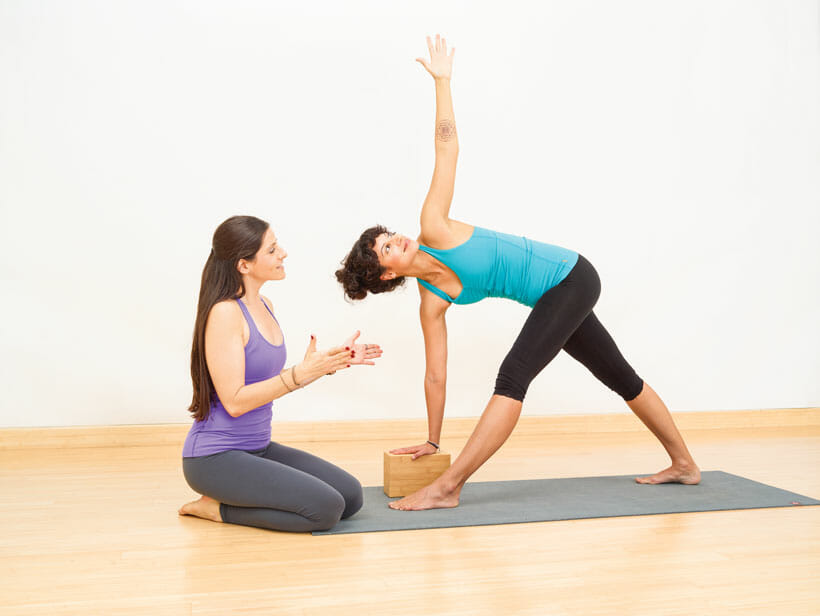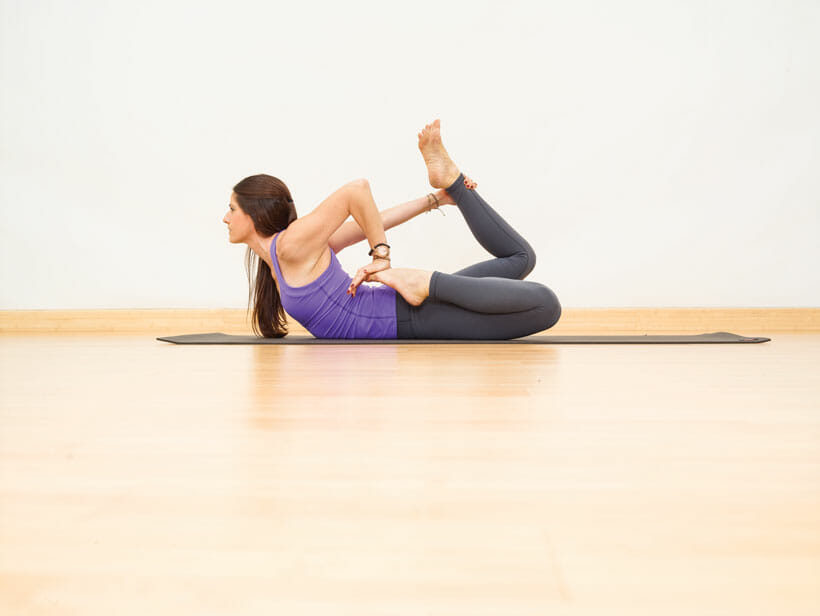
Sarah Ezrin and Hands-On Adjustments with Students. Photo by Scott Mitchell
Fine-tuning hands-on adjustments
I participated in injuring a student once. There was no pop. There was no scream. In fact, in the moment, there was nothing that told me I had done anything wrong, including the student. I remember her body moving easily as I brought her hands to grab her feet in bound padmasana (lotus). I remember us smiling and talking through the entire adjustment. Yet, something did not feel right for her afterwards and for that I take responsibility. A student was hurt by my adjustment, but I still believe in using hands-on adjustments.
I also have been injured in adjustments. Yes, plural. I did not speak up when someone pushed my thighs down too hard in baddha konasana (cobbler’s pose) or when I felt a pop in my spine during an assisted drop back into urdhva dhanurasana (upward facing bow) or when someone tried to spread my pelvis apart in trikonasana (triangle pose). In fact, in some of those instances, the pain felt good. I thought it was required to “go deeper,” to take my posture to “the next level.” I was hurt by an adjustment, but I still believe in using hands-on adjustments.
Yoga, Injuries, and Hands-On Adjustments
There is a lot of discussion these days around yoga and injury. As more people are practicing, reports of strains and pains thought to be linked to yoga are also increasing. A 2016 study conducted by Yoga Journal and Yoga Alliance reported that the number of people practicing yoga in the US has increased by 50% just since 2012. According to this study, 36 million people are now doing yoga. Those are a lot of moving bodies, and as with any physical activity, a lot of opportunities for injury.
While it is strangely ironic to think that a practice meant to heal may cause harm, injuries in yoga can occur in myriad ways. Some are due to repetitive stress, meaning a pose (or series of poses) repeated over and over puts strain on the joints or muscles. This is either because the practitioner loses attention to alignment due to fatigue from repetition (think vinyasa after vinyasa) or because the posture was misaligned in the first place. Keep driving your car with crooked alignment and a tire will eventually burst!
Some injuries are related to poor warm-up. This is a common cause of injury among yoga teachers, who will often demonstrate an advanced posture cold, only to hear the haunting sound of a pop. San Francisco-based yoga teacher Laura Burkhart recently shared her experience on YogaJournal.com. Demonstrating a complex pose led to a nearly two-year hip injury that she is still recuperating from. Finally, there are a great deal of injuries caused by forcing one’s body into a shape that is inappropriate. These can be self-inflicted, like pushing too hard in a pose, or sometimes this type of injury occurs through the teacher via a hands-on adjustment.
The Intimacy of Hands-On Adjustments
“Hands-on adjustments” do not always involve hands. In fact, many teachers adjust using their entire body. Some instructors will lie on top of a student in a forward fold or use their foot to ground a body part that is lifting, for example stepping on a person’s back outer foot in virabhadrasana 1 (warrior 1). Adjusting is a privilege. It involves coming into someone’s personal space and manipulating their energy by way of the body. It can be very intimate!
There is a common assist where the teacher will lower the student’s front rib cage. This means touching someone’s stomach, an area that some people do not even let their lovers touch. When we place our hands on another being, we need to be fully present. We need to feel that person’s breath as if it were our own. Helping someone find space and bringing breath to their body is a gift. A good adjustment can literally feel like you have brought someone to life.
With the onslaught of controversies coming to light these days around physical touch, both in the yoga world and our greater culture, some yoga teachers are learning to be trepidatious about putting their hands on students. The #metoo movement has given forum for sexual assault victims and yogis around the world to finally speak up about inappropriate adjustments and encounters.

Sarah Ezrin with Student. Photo by Scott Mitchell.
Adjusting our Adjustments
Gone are the days when we treated our teacher’s word (and adjustments) as authority. Instead, we are entering a new phase. A phase where people are saying something when things do not feel right. Where people are learning to say, “No, I do not want to be touched today,” and more importantly, where the student is the one who holds the power. It is an empowering thing to be able to say “No,” whether you are the receiver or the giver of an adjustment.
But what of those teachers who still believe in adjustments as teaching tools? How do we navigate these delicate waters of not knowing who to adjust and who not to? How much pressure is too much, and how do we know when and if we should take a student physically further?
I believe that some of the most informed and healing work I do as a teacher is by placing my hands on another. For the kinesthetic learner, a physical adjustment may be more easily understood than any verbal cue. It is precisely because adjustments are such powerful teaching tools that they should not be taken lightly. Instead of dismissing all adjustments as scary or dangerous, let us instead adjust our adjustments.
Here are 5 ways to keep your students and your own body safe when giving physical adjustments:
1. A little tap goes a long way.
In the early part of my teaching, I assisted in the Ashtanga room of a well-known Los Angeles studio. Strong adjustments were expected and encouraged. Ashtangis are daily practitioners and a strong adjustment is part of the culture. Yet, most students that come to public classes are coming in before, after, or even during a long day of work or taking care of their family. They practice one to four times a week, if they are lucky. This means tighter bodies and corresponding energy.
A strong adjustment may not be appropriate for someone who you see once a month or a couple of times a week. Instead, using a light tap to alert a part of the body that needs to wake up or lengthen can not only have a greater effect than yanking them into position, it educates the students how to engage, empowering them in their practice. Less is often more.
2. Just because the body is ready, does not mean the mind is ready.
I had a private client who was quite able-bodied. She was a novice to yoga when we met and progressed very rapidly in our sessions. Eager to learn more, she would bring me pictures of poses she hoped to work on. While she was quite flexible in her upper spine and shoulders, she would hold her breath and sweat profusely in deep backbends. She desperately wanted to do urdhva dhanurasana (upward facing bow).
One day after much preparation, she asked that I lift her into it. We had been leading up to it for months, so it was worth an attempt, although I would let her be in total control. I had her grab my ankles and braced my hands under her shoulders. She lifted her hips and then began pushing into my ankles.
Before I even had a moment to cue the next action, her breath shut off and her body went stiff like rigor mortis. I had her come down right away since I could see that her body was more than capable of doing the posture, but emotionally and energetically, she was not. I would not have served her by yanking her into the shape too soon. Instead, I let her rest and we decided to keep working on the preparatory poses, so she could find her breath before revisiting the advanced shape.
3. Like sex, good communication is everything.
“Is this OK?” can be a game-changing question when it comes to hands-on assists. I train teachers around the world and there is always one person in the trainings who is so eager to adjust that they jump right in and crank away before really looking and sensing the body before them. We must slow our entrance down as we enter the student’s energy field. This will give us a read.
I am often asked, “How do you know if someone does not want to be adjusted?” The answer is, “We ask.” Before you place your hands on the person, you ask, “Is this OK?” Once you have your hands on them, ask again, “Is this OK?” As you start to move them, ask again, “Is this OK?” And even upon exiting it is okay to ask, “Was that OK?” Communicating with your students is a great way to learn more about them and their needs, but it also teaches them to speak up and take control.
4. Just say no.
“No Touch” chips and placards are becoming more commonplace at studios. This is a private way for students to “voice” their request without having to literally say the words. Some teachers announce that they will be adjusting during class and in a posture where people’s eyes are closed or heads are down like balasana (child’s pose), they do a blind vote and ask students to raise their hand if they do not want to be touched. Just as the student can request not to be adjusted, we teachers can also say no to giving one.
Back to the Ashtanga room: there would be large men begging for me to push on them harder. Even using all my body weight and leveraging, I was not strong enough to give certain adjustments and the more I exerted, the more I put my own body at risk. The number one rule of adjustments is to protect your own body first! A sensation junky may ask for more and it is tempting to want to give in (many of us teach for a living because we are people-pleasers), but as yoga teachers our body and our health are priority. Never risk your body to adjust another!
5. Continue to evolve.
The physical practice of yoga is constantly transforming. Different schools have different beliefs and ways of doing things. Teachers shift how they teach with age. Continue to study anatomy and injury management, as it changes with time and science. We are nowhere near finished with learning after a 200-hour training. It is just the beginning.
Take trainings and workshops with teachers that you respect and look up to, but more importantly who continue to learn themselves. Read books. One of my favorites is the Anatomy Coloring Book. I have learned so much about the body by taking the time to color in muscles and bones. Many local colleges offer introductory Anatomy courses. Above all, never stop practicing. The most important adjustments are the ones we give ourselves when we take the time to find space for breath through alignment.
It is not our job to fix anyone.
I know, I know. We’re teachers. We’re there to teach people. And sometimes a pose looks so messy that we are moderately convinced a student may kill themselves; but even as teachers we are not there to “fix” anyone. We are guides. We are there to awaken a student’s innate knowledge. To help people realize that they don’t need fixing, because their innermost nature is perfect. We are there to remind students that the poses are merely tools to steady the mind. Of course, we need to protect our student’s bodies and re-align them if something is wildly unsafe, but if we go into the class with the idea that we’re there to fix people, that energy will be conveyed in our adjustments.
Instead, let your intention be to guide your students toward space and breath. Remember that every time we hands-on-assist it is an honor to place our hands on another human being. An adjustment can bring a student to life. Let our intention be to help a yogi find freedom. After all, is that not yoga?

Sarah Ezrin is the author of The Yoga of Parenting: Ten Yoga-Based Practices to Help You Stay Grounded, Connect with Your Kids, and Be Kind to Yourself. She is a freelance writer, yoga educator, and content creator based in the Bay Area. Her willingness to be unabashedly honest and vulnerable along with her innate wisdom, make her writing, teaching, and social media great sources of healing and connection for many people.
Sarah brings a wide spectrum of life experiences into everything she does. She is unafraid of sharing all sides of herself. She does so in the hope of giving others permission to be their most authentic self. At this time, when honest self-awareness is so important, Sarah’s is an essential and exemplary voice.
Sarah writes extensively on the subjects of yoga, parenting, and mental health, often interweaving these themes. Her work ranges from heavily-reported assignments to personal essays to blog content for brands. She is a regular contributor for Yoga Journal Magazine, Motherly, Yoga International, Healthline, Scary Mommy, Mind Body Green, Mantra Magazine, and LA Yoga Magazine. She has been featured in the Wall Street Journal, Forbes Magazine, Bustle, LA Weekly, and NBC News.
Sarah is a well-respected yoga teacher and a leader in the wellness community. A world traveler since birth, she has led trainings, workshops, and retreats locally and across the globe.
